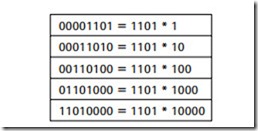Intermediate Compression Systems
Consider the 8-bit digital values: 00001101, 00011010, 00110100, 0110100, and 11010000. (Eight bit examples are used because the process is easier to follow but the following principles apply in just the same way to digital audio samples of 16 bits or, indeed, any word length.) We might just as correctly write these values thus:
If you think of the multipliers 1, 10, 100, and so on as powers of two then it’s pretty easy to appreciate that the representation given earlier is a logarithmic description (to the log of base two) with a 4-bit mantissa and a 3-bit exponent. So already we’ve saved 1 bit in 8 (a 20% data reduction). We’ve paid a price of course because we’ve sacrificed accuracy in the larger values by truncating the mantissas to 4 bits. However, this is possible in any case with audio because of the principle of masking, which underlies the operation of all noise reduction systems. Put at its simplest, masking is the reason we strain to listen to a conversation on a busy street and why we cannot hear the clock ticking when the television set is on: loud sounds mask quiet ones. So the logarithmic representation makes sense because resolution is maintained at low levels but sacrificed at high levels where the program signal will mask the resulting, relatively small, quantization errors.
NICAM
Further reductions may be made because real audio signals do not change instantaneously from very large to very small values, so the exponent value may be sent less often than the mantissas. This is the principle behind the stereo television technique of NICAM, which stands for near instantaneous companded audio multiplex. In NICAM 782, 14-bit samples are converted to 10-bit mantissas in blocks of 32 samples with a common 3-bit exponent. This is an excellent and straightforward technique but it is only possible to secure relatively small reductions in data throughput of around 30%.
